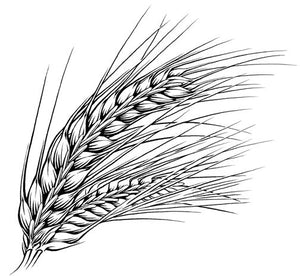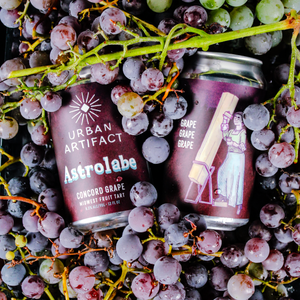Spent grain for almost every craft brewer is more of a hassle than a value-added side stream. More waste and refuse, rather than protein rich fiber source. As a brewer grows into the industrial scale, there are options for spent grain that don’t cost money, rather, they can bring in money for a brewery! Turning what has long been an organic issue in the industrial era, into a ruminant feed that can be sold for a modest sum. Agribusiness giant Cargill has created a whole business unit on their Sweet Bran product, which is simply left over corn husks from making High Fructose Corn Syrup.
However, there are solutions for the “little” craft beer brands and consumers alike. Spent grain has been a side product of brewing for as long as human civilization has been brewing beer (and even existed!). Prior to the industrial revolution spent grain had plenty of uses for townsfolk and their livestock alike. Nowadays most brewers give their spent grain away to local farmers. For Urban Artifact we give our spent grain to our friendly neighborhood dairy farmer, Farmer Lynn.
His cows, all Jersey Browns, produce a high-quality milk that is rich in fats, perfect for cheese making. Cows and other livestock alike, find spent grain delightful. By the time the farmer picks the grain up it has slightly fermented and is generally still rich in some sugars. It is a tasty treat! By co-opting the disposal of spent grain with local farmers, brewers are able to interject themselves directly into the local food movement, as well as provide a high-value product free of charge to local small farmers, many of whom greatly appreciate the savings!
Now, most of you are probably thinking, well why does any of this matter to me? Whelp, fret not urban homesteader, there are options aplenty for you as well. Brewers are want to give away their spent grain, and they generally have no problem sharing spent grain with any local person looking to score several pounds. If you happen to have chickens in your yard, this is the perfect way to supplement their diet on a budget! Additionally, spent grain is great compost if your compost pile at home is short on nitrogen rich organic material. Finally, and probably the best way to use spent grain at home is for baking! Spent grain can be turned into pizza crust (Jackie O’s sells it at their brewpub!), or baked into bread, or even turned into dog treats. Below are some select recipes that have worked for me in the past. Next time you are in a baking mood, email or call up your local brewery and ask for some spent grain, it adds a wonderfully rich element to fresh baked goods and pairs perfectly with beer!
Cheers,
Bret Kollmann Baker
Chief of Brewing Operations
--------------------------------
Spent Grain Pizza Crust (recipe courtesy of Draft Magazine)
Makes: Makes 1 1⁄3 pounds
Ingredients:
- ¾ cup lukewarm water (105-115 degrees)
- 1 package active dry yeast (2¼ teaspoons)
- 1 teaspoon sugar
- 1¼ cups all-purpose flour
- 1 cup bread flour
- 1 cup spent grain
- ½ teaspoon salt
Instructions:
• Food processor method: Pulse water, yeast, and sugar in a food processor to combine and let stand until the yeast starts to bubble, about 5 minutes. Add flours, spent grain and salt and pulse until it forms a ball, then process for 30 seconds. (You may need to adjust the water or flour depending on the type of grain used.)
• By hand method: Whisk water, yeast, and sugar in a large bowl and let stand until the yeast starts to bubble about 5 minutes. Stir in flours, spent grain and salt. Dump onto a floured surface and knead until the dough is smooth and elastic about 5 minutes.
• Place the dough in a large bowl coated with oil, cover with a clean kitchen towel and let rise in a warm, draft-free place until doubled in size, about 1 hour. To make the dough ahead of time, cover and refrigerate the unrisen dough for up to 1 day, or tightly wrap the unrisen dough in an oiled plastic wrap, freeze for up to 3 months, and defrost the dough overnight in the refrigerator. Let the dough come to room temperature before rolling.
• When ready to bake, roll the dough into a circular slab and place on a pizza stone or tray. Top with your choice of cheeses, sauces, veggies, and meats, and bake at 425 degrees for 15 to 20 minutes, or until the crust is golden and the cheese is melted.
Spent Grain Pancakes (recipe courtesy of Draft Magazine)
Makes: 10
Ingredients:
- 4 eggs
- 4 cups buttermilk
- ½ cup oil
- 1 teaspoon vanilla
- 1-ounce honey
- 4 cups self-rising flour
- 2 tablespoons sugar
- 1 teaspoon baking soda
- 1 teaspoon salt
- 2 cups spent grain
Instructions:
• Heat a griddle over medium heat.
• In a large bowl, beat together the eggs, buttermilk, oil, vanilla, and honey. In a separate bowl, combine the flour, sugar, baking soda and salt. Add the dry ingredients to the egg mixture 1 cup at a time, stirring until well-combined. Add the spent grain, and stir until just incorporated into the batter.
• Working in batches, drop the pancake batter onto the hot griddle using about 1/3 cup of batter for each pancake. Cook until bubbles form, 1 to 2 minutes; flip, then cook 1 to 2 minutes more, until both sides of the pancakes are light golden brown. Keep covered until ready to serve.
Spent Grain Dog Treats (recipe courtesy of Brew-Your-Own Magazine)
Special Note: Hops are poisonous to dogs. Make sure that there are no hops in the mash. Your brewer can confirm for you that the spent grain is hop free.
Dog Biscuit Recipe
(yields 40 medium-sized biscuits)
Ingredients
4 cups spent grain
1 cup peanut butter
2 cups flour
2 eggs
Step by step
1. Mix the ingredients together and press the dough onto parchment or wax paper, about 1⁄4 thick.
2. Cut the pressed dough into shapes with a cookie cutter or using a knife.
3. Place the treats onto parchment paper on cookie sheet and place in a 350 °F (177 °C) oven.
4. Bake at 350 °F (177 °C) for 30 minutes.
5. After 30 minutes, drop the oven heat to 225 °F (107 °C) and bake for two hours. When the treats come out they should be dry and crunchy so they do not spoil/mold. If they are not dry after two hours, increase time at 225 °F (107 °C). You want to dry them, but not cook them to the point where they are hard to break.







